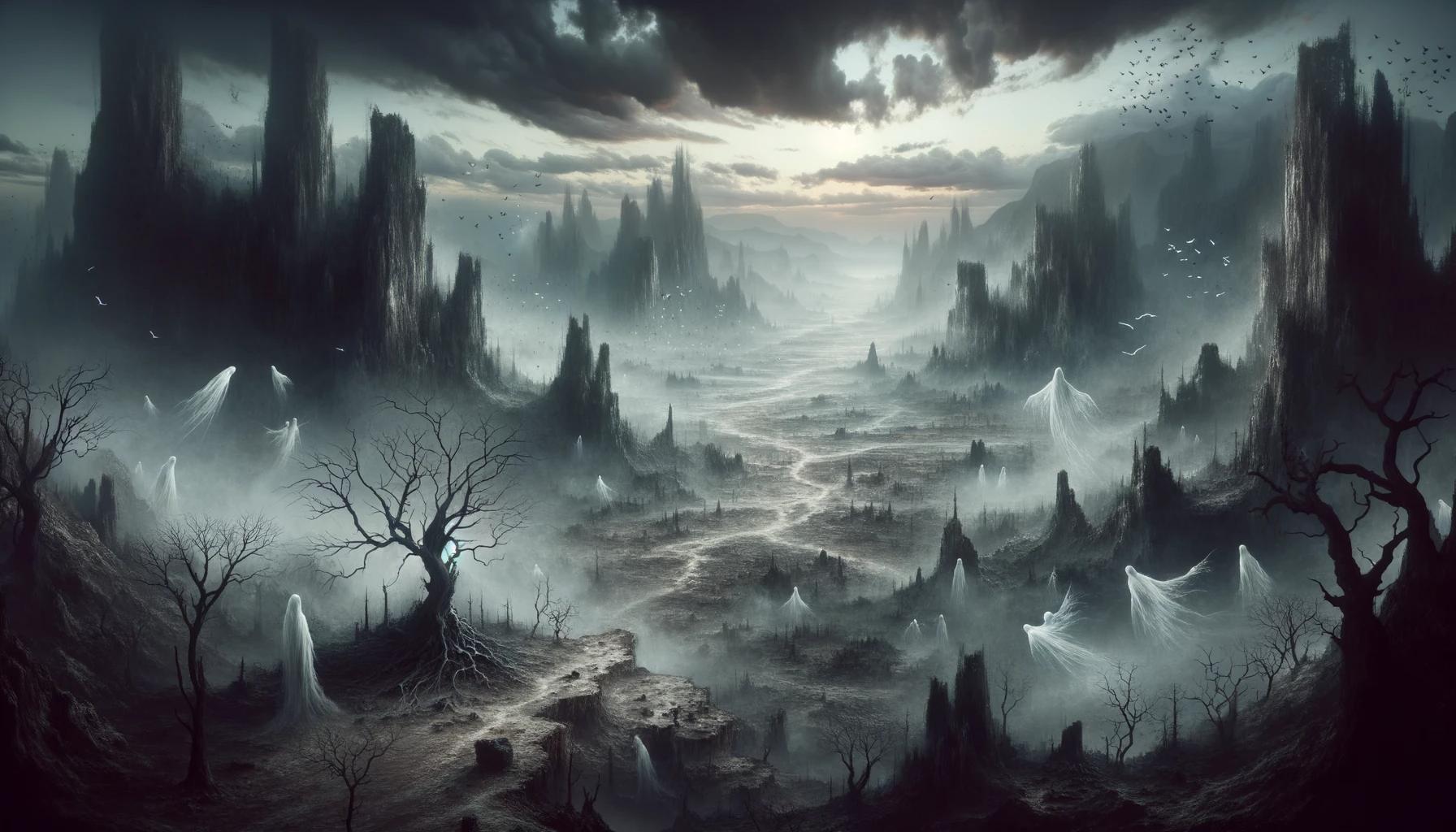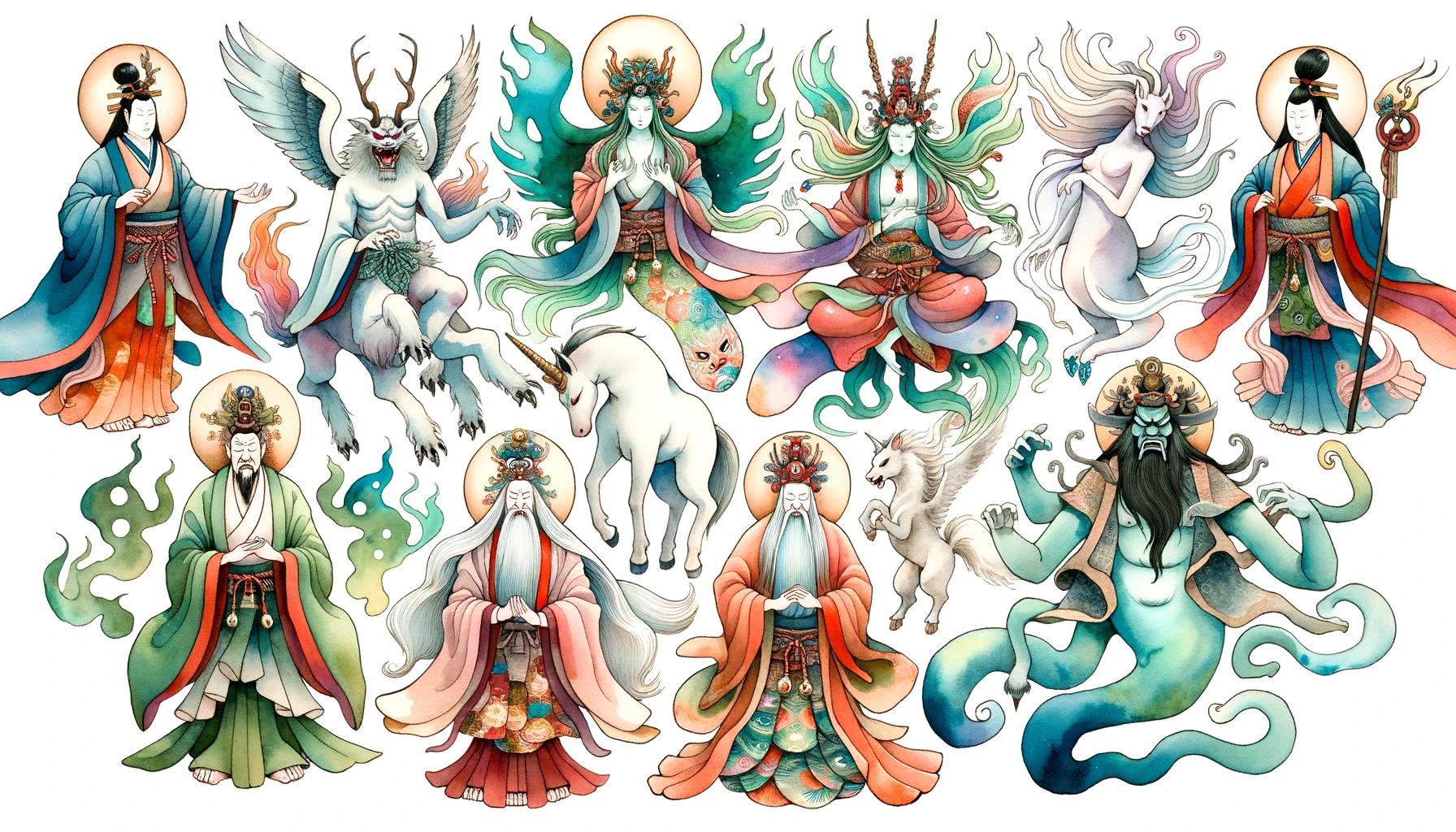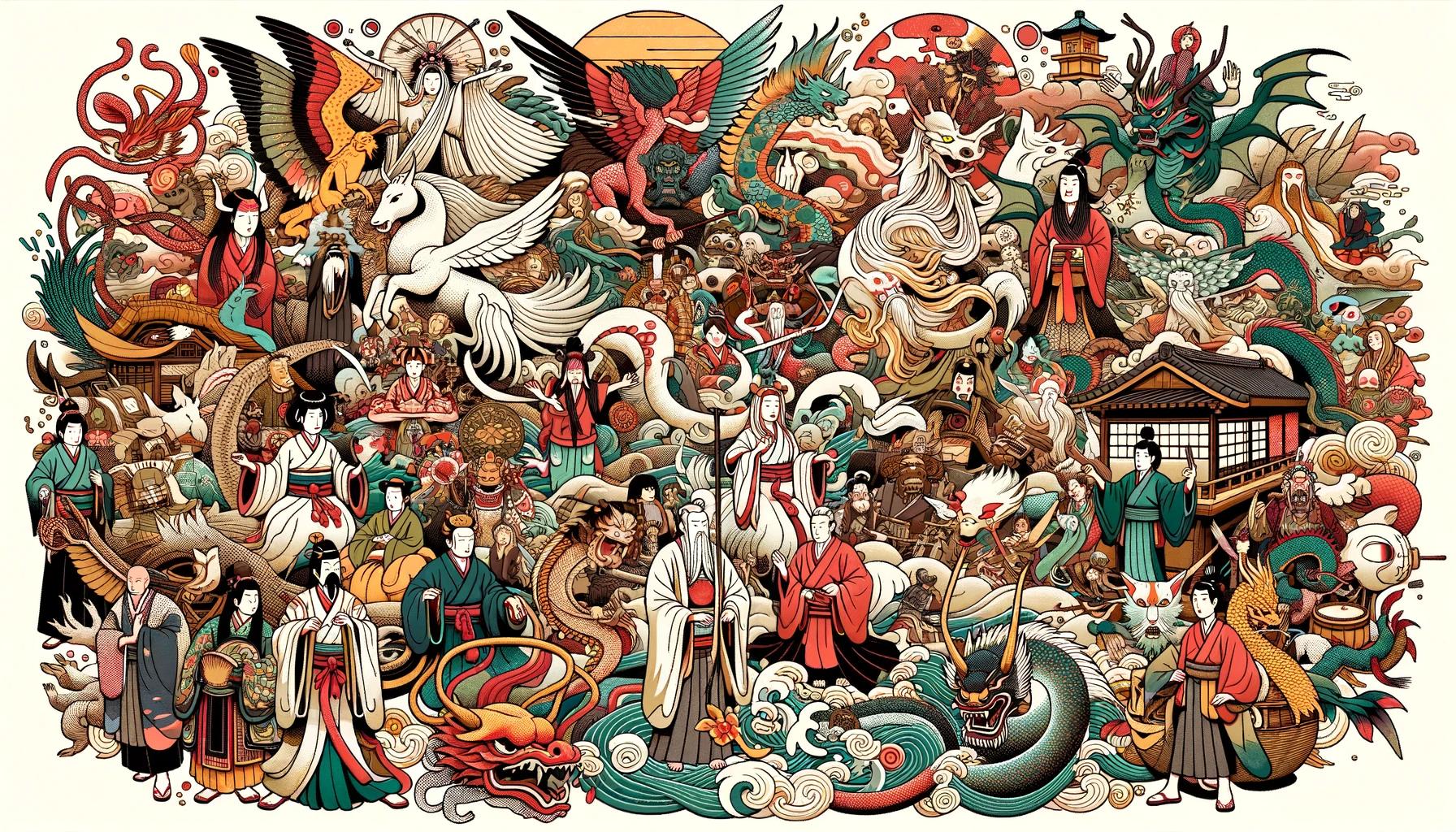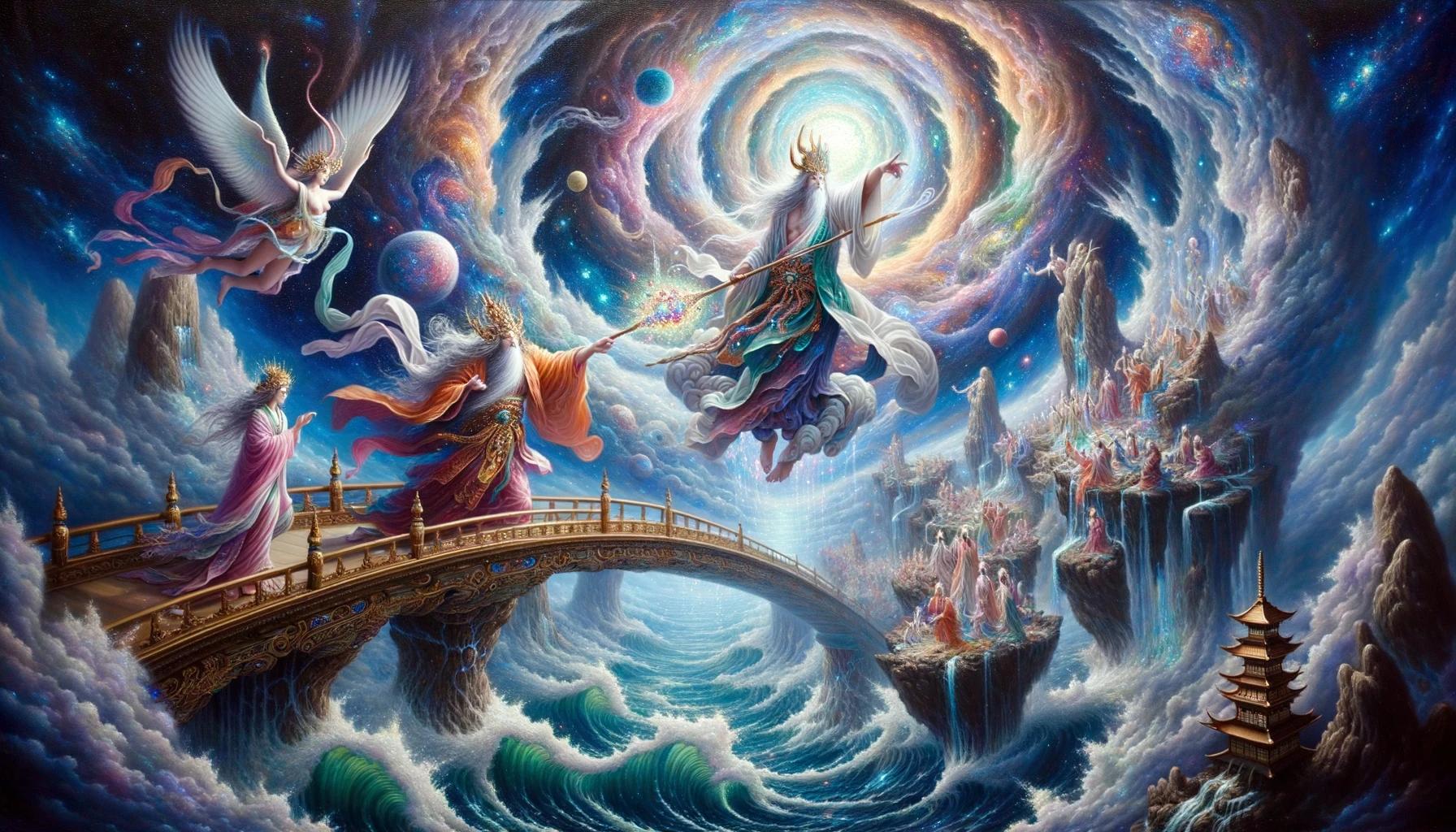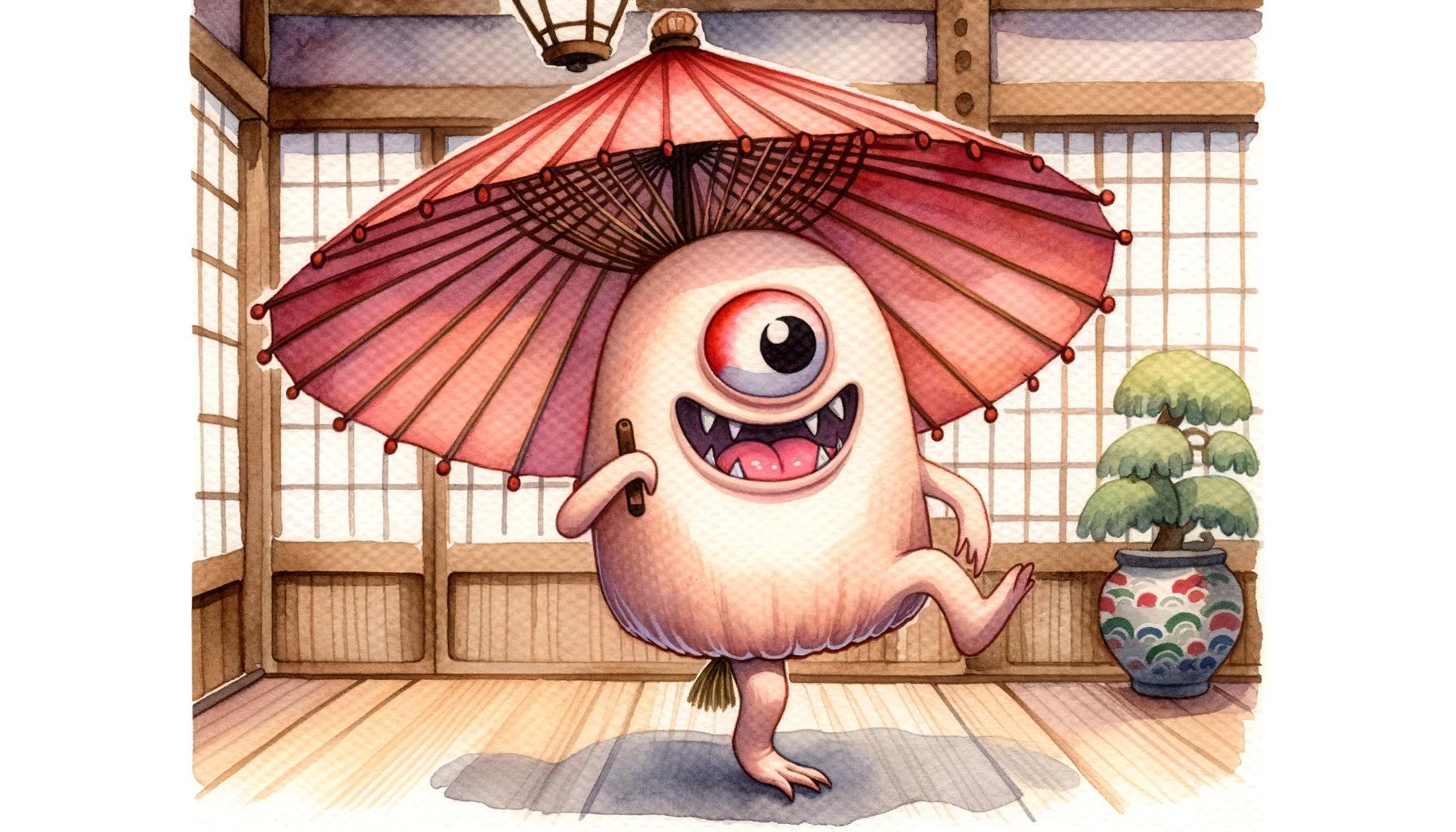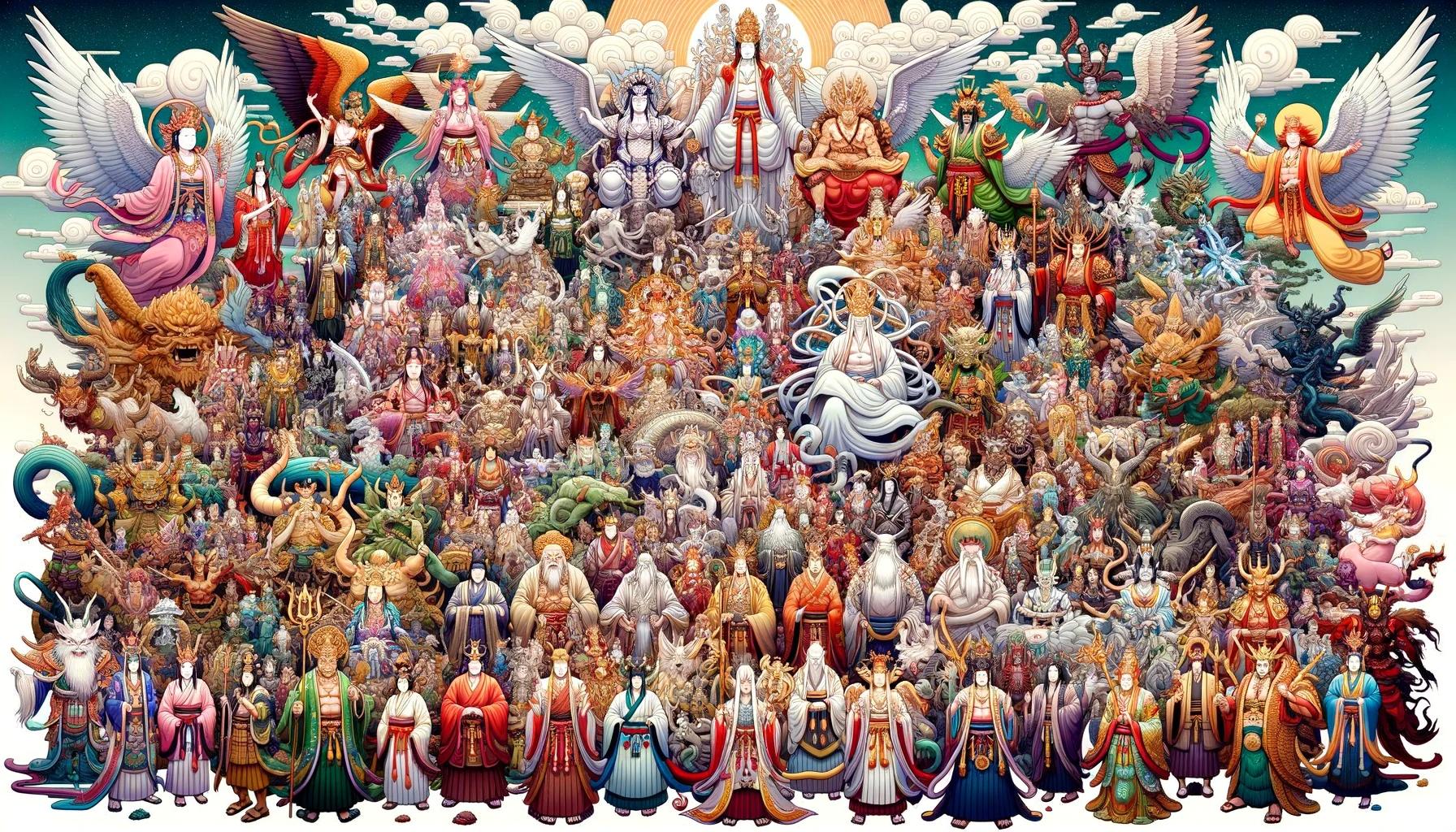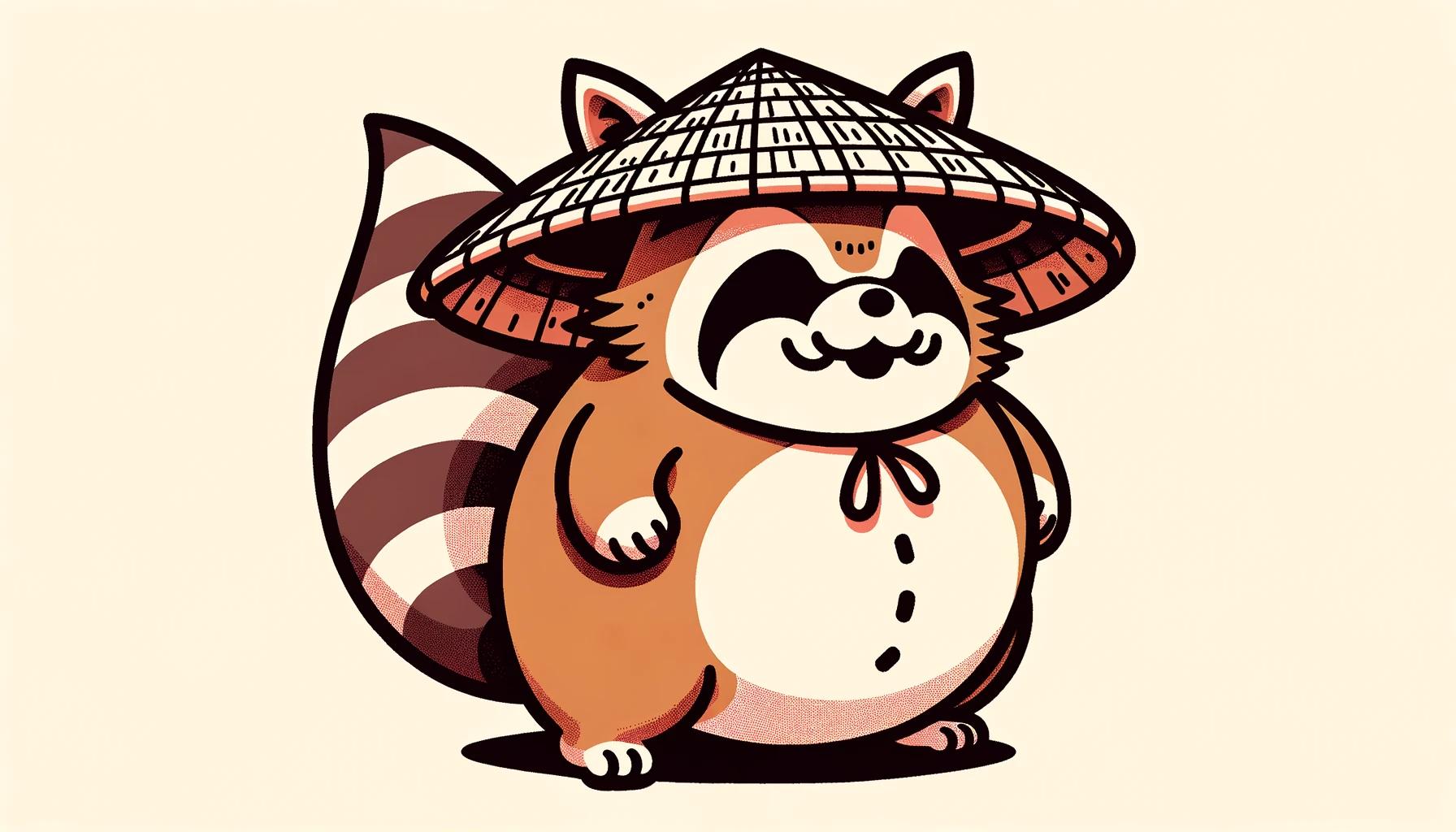What is Hell in Japanese Mythology: Exploring the Underworld in Japanese Folklore
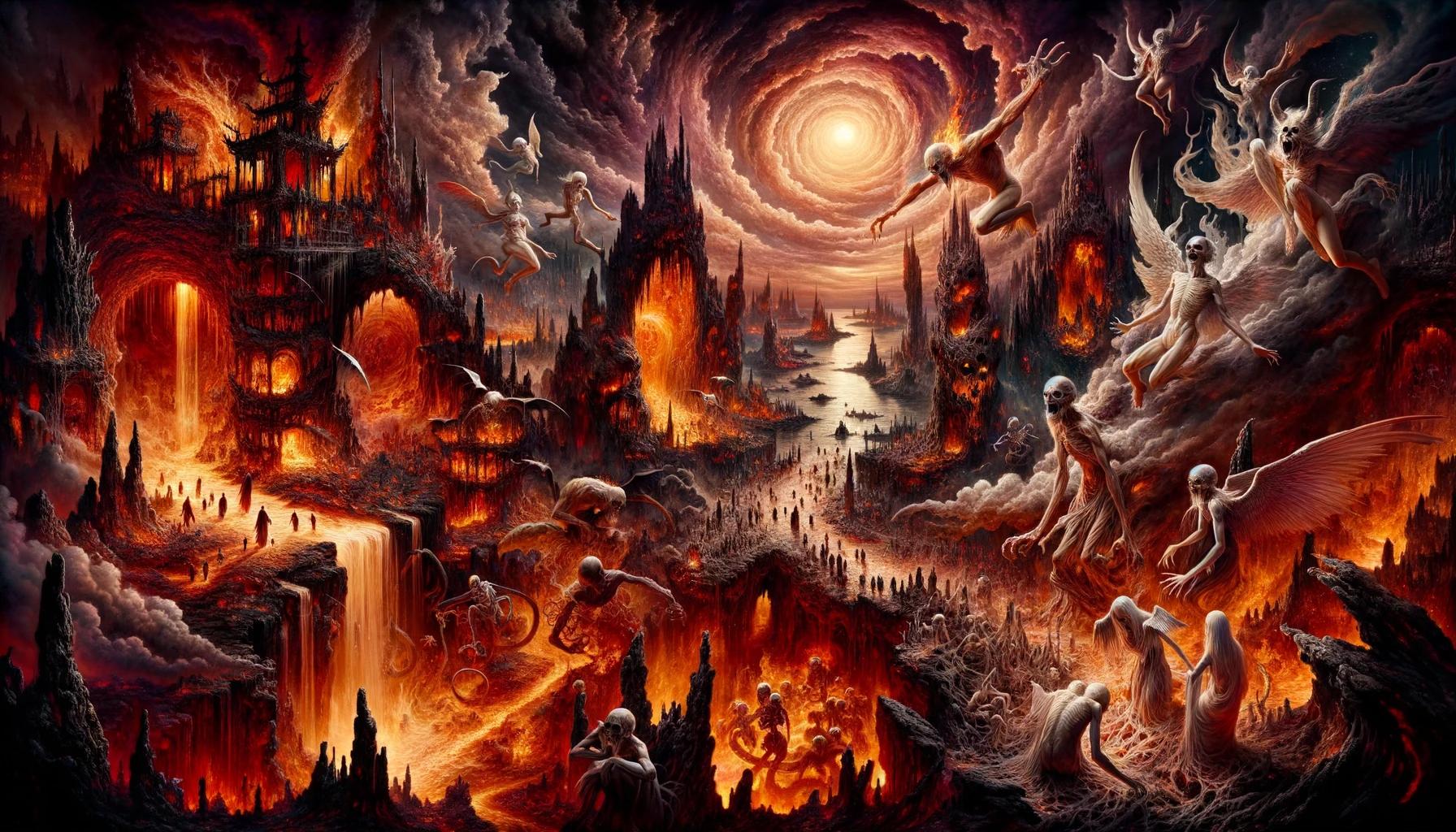
In Japanese mythology, Hell, known as Jigoku, is a widely believed region consisting of various hot and cold realms beneath the Earth. Ruled by Emma-ō, the Japanese lord of death, Jigoku is where the deceased are judged based on their sins.
The intricacy and diversity of Jigoku are depicted in the Jigoku-zōshi, a 12th-century scroll presenting the eight major hells and sixteen minor hells. With connections to Buddhist concept of naraka and Chinese concept of diyu, Jigoku is considered the worst destination after death for those deemed unworthy of reincarnation in the higher realms.
Punishments in Jigoku vary, with multiple judgments and opportunities for salvation. The article explores the structure of Jigoku, its rulers and guardians, and the various hells and punishments within it.
The Concept of Hell in Japanese Mythology
In Japanese mythology, the concept of Hell, known as Jigoku, holds a significant place within the cultural fabric of Japan.
It is a realm believed to exist beneath the Earth, composed of various hot and cold regions where the souls of the deceased are judged for their sins. Understanding the origins and influences behind this concept provides valuable insights into the rich tapestry of Japanese folklore.
Origins and Influences
The origins of Jigoku can be traced back to ancient beliefs in Japan, influenced by both indigenous and foreign religions and mythologies. It combines elements from Shintoism, the native religion of Japan, and Buddhism, which was introduced to the country in the 6th century.
These diverse influences shaped the imagery and narratives associated with the concept of Hell in Japanese mythology.
Cultural Significance of Hell in Japanese Folklore
Within Japanese folklore, Hell holds immense cultural significance as a realm of punishment and redemption. It serves as a moral compass, reinforcing the consequences of one’s actions in life and the importance of leading a virtuous existence.
The stories and depictions of Hell in Japanese folklore have captivated generations, imparting important moral lessons and moral codes to the society.
Comparison with Hell in Buddhism and Chinese Mythology
Jigoku shares similarities with the Buddhist concept of naraka and the Chinese concept of diyu, showcasing the interconnectedness of East Asian mythologies. While these realms of the afterlife might differ in their specific details and cultural interpretations, they share common themes of punishment, judgment, and the potential for salvation.
Understanding these comparisons sheds light on the universal human fascination and exploration of the concept of Hell.
Jigoku: The Japanese Underworld
The Japanese underworld, known as Jigoku, is a fascinating realm that holds significant cultural and religious significance in Japanese mythology. In this section, we delve into the description and structure of Jigoku, as well as explore its rulers and guardians.
Description and Structure of Jigoku
Jigoku is believed to be located beneath the Earth, consisting of various hot and cold regions. It is a realm of punishment and judgment for the deceased based on their sins committed during their lifetime.
The complexity and diversity of Jigoku are depicted in the Jigoku-zōshi scroll, a late 12th-century manuscript showcasing the eight great hells and sixteen minor hells in both text and paintings. This scroll provides a vivid representation of the different regions and the specialized forms of punishment within Jigoku.
Rulers and Guardians of Jigoku
Emma-ō: The Lord of Death
At the helm of Jigoku is Emma-ō, known as the lord of death in Japanese mythology. He is responsible for judging the souls of the deceased, consulting a register that records all their sins and determining their sentences.
Emma-ō plays a crucial role in the examination of the dead, overseeing their judgments and ensuring that justice is served.
Miru-me and Kagu-hana: Assistant Judges of the Dead
Assisting Emma-ō in the examination of the souls are two disembodied heads known as Miru-me and Kagu-hana. Miru-me possesses the power to perceive the most concealed flaws of the sinners, while Kagu-hana can detect any wrongdoing.
Together, they aid Emma-ō in the thorough judgment and punishment of the deceased, ensuring that their sins are appropriately addressed.
Jigoku’s structure and the presence of these influential rulers and guardians deepen the understanding of this mythical realm, its processes of judgment, and the fitting punishments that await those who have transgressed in their earthly life.
The Eight Great Hells of Jigoku
In Japanese mythology, Jigoku consists of sixteen different hells, categorized into eight “Hot Hells” and eight “Cold Hells.” Each of these hells has its own unique forms of punishment and duration of stay.
Let’s delve into the terrifying realms of Jigoku and explore the punishments that await the sinners.
Hot Hells
The Burning Hell
Within this scorching inferno, condemned souls endure the unbearable agony of being burned alive repeatedly. Tormentors wield fiery weapons, and the ground itself is ablaze, intensifying their suffering. The punishment in this hell lasts for a period of time equivalent to 500 human years.
The Hell of Screams
Those consigned to the Hell of Screams endure constant torment as their agonizing cries reverberate throughout the fiery abyss. Fiends clad in demonic forms mercilessly inflict pain upon the damned.
The torment in this hell persists for a staggering duration of 4000 years.
The Hell of Crushing
In this terrifying realm, sinners are continually crushed between mountains of iron, reducing their bodies to a gruesome pulp. Additionally, they face the menacing blades of trees covered in razor-sharp leaves, which shred their flesh.
As if that weren’t enough, demons and beasts feast upon their remains. The punishment in this hell exceeds 106 trillion human years.
The Hell of Reviving
Reserved for those guilty of murder, the Hell of Reviving inflicts excruciating and relentless pain upon its inhabitants. Souls are torn apart repeatedly by ferocious oni wielding iron claws, forcing them to experience the agony of death countless times.
This punishing sentence extends for 500 years.
Cold Hells
The Hell of Black Threads
Relegated to those who commit not only murder but also theft, the Hell of Black Threads subjects souls to a gruesome punishment. The condemned are marked with black threads and systematically torn apart along these marks.
Furthermore, they must carry heavy stacks of burning iron on a tightrope above a massive boiling pan, only to be shredded upon falling. The punishment in this hell spans a thousand years.
The Hell of Snow and Ice
In this frozen realm, souls endure the chilling bitterness of extreme cold. They are subjected to icy winds and blizzards that pierce their bodies, leaving them in a state of everlasting torment.
The duration of their sentence in this frigid hell is a thousand years.
The Hell of Razor-Sharp Leaves
Sinners who find themselves in the Hell of Razor-Sharp Leaves face the terrifying prospect of climbing trees adorned with leaves as sharp as blades. As they ascend, lured by the seductive calls of beautiful men and women, their bodies are sliced apart, their blood flowing as giants, demons, and beasts eagerly consume their flesh.
A life in this hell is equivalent to over 106 trillion human years.
These eight great hells illustrate the extent of the horrors that await those condemned in Jigoku. The punishments are uniquely designed to match the sins committed, ensuring that justice is meted out in the afterlife, according to Japanese mythology.
Lesser Hells and Other Punishments
Within the intricate underworld of Jigoku, there exist not only the eight great hells but also lesser hells designed for specific crimes. These punishments are tailored to the sins committed and showcase the intricacy of Japanese mythology’s depiction of the afterlife.
Punishments for Specific Crimes
Hell for Killers and Thieves
In the realm of Kokujou Jigoku, reserved for those who commit the sin of murder and theft, the condemned souls bear black threads marked upon them. These wretched souls are torn apart along the markings, forced to carry heavy piles of hot iron across a tightrope above a giant, boiling pan.
Falling results in further torment and destruction. The punishment in this hell lasts for a period of one thousand years.
Hell for Lusty Sinners
For those who not only embrace violence but also indulge in lustful desires, Shugou Jigoku awaits. In this hell, sinners are repeatedly crushed between iron mountains, reducing them to a bloody pulp.
Lascivious inhabitants are tasked with climbing trees adorned with razor-sharp leaves, cutting their own bodies in the process. Upon reaching the tree’s top, they are lured by beautiful men and women who, amidst the blood and severed body parts, become prey for giants, demons, and beasts.
A lifetime within this hell is said to be equivalent to more than 106 billion human years.
Hell for Drunkards and Alcoholics
Kyoukan Jigoku, also known as the Hell of Screams, is designated for those who have committed sins through murder, theft, and indulgence in alcohol. Sinners are submerged in boiling cauldrons or enclosed within iron chambers, while demons roast them over fires.
Those who have committed crimes under the influence of alcohol have molten iron poured into their bellies, intensifying their screams of anguish. The punishment in this hell persists for four thousand years, totaling more than 852 billion years.
Hell for Liars and Deceivers
Dai-kyoukan Jigoku, the Hell of Great Screams, houses murderers, thieves, promiscuous individuals, drunkards, and those who deceive others. The tongues of these condemned souls are pierced and stretched, symbolizing their inability to speak the truth.
They experience excruciating pain and are tormented by oni, demonic entities, for eternity. This particular hell illustrates the severity of punishment for those who engage in various forms of wrongdoing.
These lesser hells showcase the distinct and tailored punishments that await those who have committed specific crimes.
The vivid descriptions of each punishment emphasize the depth and complexity of Japanese mythological beliefs surrounding the afterlife.
Trials and Salvation in Jigoku
In the realm of Jigoku, the afterlife is fraught with trials and opportunities for salvation. After death, the souls must endure a series of judgments to determine their fate. These judgments are conducted by the rulers of Jigoku at different intervals, offering chances for the release from the eternal torment.
Judgments and Sentences in Jigoku
The first judgment takes place 100 days after death and is presided over by King Byoudou, also known as Kannon Bosatsu or Guanyin. The sins of the deceased are weighed and assessed during this initial judgment.
Following this, subsequent judgments occur on significant anniversaries of the death.
In the first year after death, the judgment is overseen by the King Toshi. On the second anniversary, the soul receives another opportunity for salvation under the judgment of the King Godou-tenrin.
Some traditions also include three additional chances for salvation.
- The third judgment happens six years after death and is led by the King Renge.
- The fourth judgment occurs twelve years after death, under the rule of the King Gion.
- The final judgment takes place thirty-two years after death, under the authority of the King Houkai.
Those who fail to pass these final three tests remain trapped in Jigoku for an extended period before being reborn into one of the other five realms.
It is believed that prayers and rituals performed by the surviving family members of the deceased can influence the outcome of these judgments. Through special memorial services and heartfelt prayers, the living can seek salvation for their departed loved ones.
Throughout these trials, the souls in Jigoku are offered a chance at redemption. While the sentences in Jigoku are not eternal, the duration and nature of punishment vary depending on the specific sins committed by the souls.
Myths and Legends Surrounding Jigoku
Myths and legends surrounding Jigoku, the Japanese underworld, have captivated the imaginations of people for centuries. These tales are rich in storytelling and provide insights into the fears and beliefs of ancient Japan.
They explore the consequences of sin, the struggles of heroes, and the terrifying encounters with demons in the realm of Jigoku.
Stories of Heroes and Demons in Jigoku
Within the mythology of Jigoku, there are numerous stories highlighting the triumphs and challenges faced by heroes who descend into this infernal realm. One such tale is that of the brave warrior who ventures into Jigoku to rescue a lost loved one.
Guided by their unwavering determination, these heroes confront their fears, battle vicious demons, and overcome treacherous obstacles to achieve their goals.
Legends of Jigoku also frequently feature encounters with formidable demons that inhabit the underworld.
These demons, adorned with fearsome appearances and supernatural abilities, serve as guardians of Jigoku and tormentors of sinful souls. The tales depicting these encounters showcase the struggle between good and evil, often revealing moral lessons and warnings about the consequences of wicked actions.
Influences of Jigoku in Japanese Art and Literature
Jigoku’s vivid imagery and compelling narratives have left an indelible mark on Japanese art and literature. Paintings and illustrations depict the gruesome punishments and terrifying landscapes of the underworld, captivating viewers with their dark and intricate details.
Jigoku’s influence can also be seen in traditional Japanese theater, particularly in Noh and Kabuki plays, where the stories of Jigoku are brought to life on stage through dramatic performances.
Literature has also been greatly inspired by Jigoku, with numerous novels, poems, and short stories exploring the themes and symbolism associated with the underworld.
Many writers draw upon the notion of Jigoku as a metaphorical representation of the human condition, delving into themes of guilt, redemption, and the complexities of morality.
Modern Perceptions and Interpretations of Jigoku
Today, Jigoku continues to intrigue and captivate people’s imaginations, albeit in new forms.
Its influence can be seen in various forms of popular culture, including movies, anime, and video games. Modern interpretations often incorporate elements of horror and fantasy, offering fresh perspectives on the ancient tales of Jigoku.
Beyond entertainment media, Jigoku’s significance persists in the spiritual and religious practices of Japan. Rituals and ceremonies are conducted to honor and remember the deceased, paying homage to the journeys of souls through the world of Jigoku.
These practices provide a connection to the past and a means of contemplating the mysteries of life, death, and the afterlife.
As time passes, the myths and legends surrounding Jigoku continue to evolve and inspire, reflecting the ever-changing perspectives and interpretations of Japanese society, while preserving the enduring fascination and intrigue of this enigmatic underworld.
Traveling to Jigoku: Exploring Japanese Hellish Landscapes
Welcome to the captivating world of Jigoku, the Japanese underworld! As we delve into this realm, let’s embark on a journey to explore the intriguing landscapes that depict the concept of hell in Japanese mythology.
From ominous sites and temples to cultural practices and even pictorial scrolls, there’s much to discover.
Hellish Sites and Temples in Japan
Japan boasts several locations associated with the mythological depiction of Jigoku. One notable site is Beppu, a city renowned for its hot springs and the iconic “Jigoku Meguri” (Hell Tour), where visitors can witness remarkable geothermal phenomena and vibrant, otherworldly landscapes.
Another destination worth exploring is Osorezan, a sacred mountain in Aomori Prefecture believed to be an entrance to the underworld, offering a sense of spiritual connection to the realm of Jigoku.
Cultural Practices and Pilgrimages to Jigoku
Immersing yourself in the cultural practices associated with Jigoku can offer deeper insights into Japanese mythology. Buddhist temples across Japan hold memorial services, providing an opportunity for the living to pray and acknowledge their deceased loved ones.
Additionally, some individuals undertake pilgrimages to Jigoku-related sites, seeking purification, spiritual enlightenment, or simply a unique and profound cultural experience.
Jigoku-zōshi: The Pictorial Scrolls Depicting Hell
The Jigoku-zōshi, a remarkable piece of art from the late 12th century, presents a vivid visual representation of the realms of Jigoku. This pictorial scroll showcases the complexity and diversity of hells as depicted in Japanese mythology.
With its intricate illustrations and accompanying text, the Jigoku-zōshi provides a captivating glimpse into the torment and punishments that await sinners in the afterlife.
.

